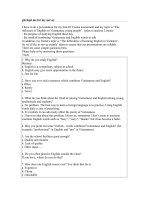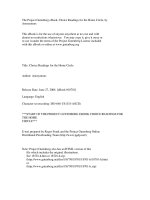Sarabanes oxley for nonprofits
Bạn đang xem bản rút gọn của tài liệu. Xem và tải ngay bản đầy đủ của tài liệu tại đây (1.9 MB, 256 trang )
Sarbanes-Oxley for Nonprofits
SarbanesOxley for
Nonprofits
A Guide to Gaining
Competitive Advantage
Peggy M. Jackson, dpa, cpcu
Toni E. Fogarty, ph.d.,mph
John Wiley & Sons, Inc.
This book is printed on acid-free paper.
Copyright © 2005 by John Wiley & Sons, Inc., Hoboken, NJ. All rights reserved.
Published simultaneously in Canada
No part of this publication may be reproduced, stored in a retrieval system, or transmitted
in any form or by any means, electronic, mechanical, photocopying, recording, scanning,
or otherwise, except as permitted under Section 107 or 108 of the 1976 United States
Copyright Act, without either the prior written permission of the Publisher, or authorization
through payment of the appropriate per-copy fee to the Copyright Clearance Center, Inc.,
222 Rosewood Drive, Danvers, MA 01923, 978-750-8400, fax 978-646-8600, or on the
web at www.copyright.com. Requests to the Publisher for permission should be addressed to
the Permissions Department, John Wiley & Sons, Inc., 111 River Street, Hoboken, NJ
07030, 201-748-6011, fax 201-748-6008.
Limit of Liability/Disclaimer of Warranty: While the publisher and author have used their
best efforts in preparing this book, they make no representations or warranties with respect
to the accuracy or completeness of the contents of this book and specifically disclaim any
implied warranties of merchantability or fitness for a particular purpose. No warranty may
be created or extended by sales representatives or written sales materials. The advice and
strategies contained herein may not be suitable for your situation. You should consult with
a professional where appropriate. Neither the publisher nor author shall be liable for any loss
of profit or any other commercial damages, including but not limited to special, incidental,
consequential, or other damages.
For general information on our other products and services, or technical support, please
contact our Customer Care Department within the United States at 800-762-2974, outside
the United States at 317-572-3993 or fax 317-572-4002.
Wiley also publishes its books in a variety of electronic formats. Some content that appears in
print may not be available in electronic books.
For more information about Wiley products, visit our Web site at www.wiley.com.
Library of Congress Cataloging-in-Publication Data:
Jackson, Peggy M.
Sarbanes-Oxley for nonprofits : a guide to gaining competitive
advantage / Peggy M. Jackson and Toni E. Fogarty.
p. cm.
Includes index.
ISBN 0-471-69788-5 (cloth)
1. Nonprofit organizations—United States—Finance—Management. 2.
United States. Sarbanes-Oxley Act of 2002. 3. Nonprofit organizations—
Accounting--Law and legislation. 4. Nonprofit organizations—Auditing—
Law and legislation. 5. Nonprofit organizations—United States—
Management. I. Title: Sarbanes-Oxley for non-profits. II. Fogarty, Toni E.
III. Title.
HG4027.65.J33 2005
657'.98—dc22
2004029119
Printed in the United States of America
10 9 8 7 6 5 4 3 2 1
In loving memory
Bernice Stinemates Barnhardt
Carlisle Stinemates
The Rev. Chandler C. Jackson
PMJ
In loving memory
Molly Davenport
Nokal Kitchens
Hoss and Weasel
TEF
Contents
acknowledgments
about the authors
preface
chapter 1
chapter 2
chapter 3
xiii
xv
xvii
Overview of the Legislation and Its Implications
for Nonprofits
What Is the Sarbanes-Oxley Legislation About?
Relevance of SOX to Nonprofits
Current Legislative Environment for Nonprofits
Conclusion
Endnotes
Safeguarding Your Nonprofit’s Financial Resources
and Assets: Establishing Auditor Independence
and Audit Committee Competence
SOX Titles II and III
The Value of Accurate Financial Statements
The Importance of a Good Audit
The Board’s Responsibility Regarding the Financial
Statements
Conclusion
Reading and Interpreting Financial Statements
Balance Sheet
Statement of Operations
Statement of Changes in Net Assets
Statement of Cash Flows
Financial Statement Analysis
Conclusion
1
1
12
13
26
26
27
28
29
30
32
38
39
42
46
49
50
52
65
vii
viii
contents
chapter 4
chapter 5
chapter 6
chapter 7
chapter 8
Form 990: Unnecessary Paperwork or a Useful Tool?
What Are Form 990 and Form 990-EZ?
Why Is Form 990 Important?
Management’s Role in Improving Form 990:
Creating a Good Internal Control System
The Board’s Role in Form 990
Conclusion
SOX Sections VIII and XI: Document Retention and
Whistleblower Protection Obligations
Whistleblower Protection
Creating a Confidential Reporting System
Document Retention, Archiving, and Retrieval
First Steps: Beginning the Process
Conclusion
Raising the Bar of Accountability: SOX Best Practices
and the Board
Legislative Environment: Best Practices and Governance
New Expectations for Board Oversight and Governance
Higher Expectations for Board Membership and
Deliberations
SOX and the Board: Higher Performance and
Greater Accountability
Championing SOX Best Practices: The Board’s
Governance Role
Conclusion
SOX Best Practices and Organizational Culture:
Changing the Environment
The Nonprofit’s Organizational Culture and the
Adaptation of SOX Best Practices
Introducing Change
Nonprofit Board Culture
Strategies for Introducing Change in the Board Culture
Conclusion
Endnote
A Platinum Operating Standard Starts
with Good Bones
SOX Best Practices: Moving to a Platinum
Operating Standard
What Are Platinum Operating Standards?
Review of Internal Controls
67
67
68
69
72
74
75
76
77
79
79
84
85
86
89
90
96
98
102
103
103
110
112
120
121
121
123
123
125
126
contents
Conducting the Review of Internal Controls
Content and Structure of the Review of Internal
Controls Report
Conclusion
Endnote
chapter 9
Creating a Competitive Advantage: Leveraging SOX
Best Practices
Competitive Advantages of Being in Compliance with
Sarbanes-Oxley Best Practices
Conclusion
Endnotes
chapter 10 SOX Best Practices for Small Nonprofits
Five Myths That Hold Small Nonprofits Back
Adopting SOX Best Practices
Scaling the SOX Best Practices to Fit the Needs of
Small Nonprofits
Keys to Success in Customizing SOX Best Practices
Conclusion
ix
133
134
135
135
137
138
154
154
155
155
157
157
162
163
appendices Best Practices: Checklists, Worksheets, and
Sample Documents
appendix a Working Through the Four Basic Financial Statements
Balance Sheet
Statement of Operations
Statement of Changes in Net Assets
Statement of Cash Flows
appendix b Whistleblower Protection Policy
165
167
167
175
181
184
189
Document Retention and Storage Protocols
Document Retention Policy—Talking Points
Writing the Policy—Talking Points
Special Designations for Sensitive Documents
Storing and Archiving the Documents
Testing the System
191
191
191
193
194
194
appendix d Audit Committee Procedures and Protocols
195
195
195
195
appendix c
Audit Committee
Composition of the Committee
Committee Functions and Deliverables
x
contents
appendix e Conflict of Interest Policy
Talking Points
Sample Conflict of Interest Letter
appendix f Code of Ethics for Board and Senior Management
Talking Points
Sample Code of Ethics for a Nonprofit Board Member
197
197
199
201
201
202
appendix g Board of Directors—Governance Profile and
Performance Expectations
Oversight and Policy Making
Term Limits
Summary of Board Committees’ Descriptions and
Performance Objectives
Process for Board Member Nomination and Election
appendix h Board Orientation Session
appendix i
appendix j
203
203
203
204
204
Outline of Curriculum
Board Binder Contents
207
207
208
Review of Internal Controls Report and
Recommendations
Overview of the Project
Systems
Recommendations and Time Line
211
211
211
212
Risk Management Plan
Profile
Risk Management Worksheets
Worksheet 1—List Areas of Concern
Worksheet 2—Tier 1 and Tier 2 Risks
Worksheet 3—Strategies for Dealing with Risk
Worksheet 4—Time Line
Worksheet 5—Risk Administration and Monitoring
Worksheet 6—Risk Management Plan Template:
Table of Contents
Sample Risk Management Plan: Table of Contents
appendix k Business Continuity Plan
Emergency Protocols
Contact Information for Board Members and Staff
Business Resumption Strategies for Each Department within
Your Nonprofit
Communication
213
213
213
214
214
215
215
216
216
217
219
219
220
220
221
contents
appendix l
index
xi
Financial Services
Vendors
Service Providers—Utilities, Water, Governmental Agencies
If Your Nonprofit Needs to Relocate
221
221
222
222
Bibliography
225
229
Acknowledgments
W
e would like to thank our editor, Susan McDermott, for her support
and interest in this project. Her encouragement spurred us on and her support has been enormously helpful.
Peg is grateful for the ongoing support and encouragement of Victoria
(“Tori”) Hill of the Library of Congress. Tori was a mainstay of support for
Peg since the days of her dissertation, and for this project, has once again
demonstrated the tremendous cooperation and dedication that Peg has
come to know from working with the staff at the Library of Congress. The
Library is truly a national treasure!
Peg is also very grateful for the ever-present support of her husband,
Paul, who has always believed in her, and their family friend, Rick Ewing,
whose support and humor puts things in perspective.
Toni is grateful for the number of people who helped her with this project, either directly or indirectly. The “Ladies Who Lunch” group has been
and continues to be a great source of inspiration, and provides comic relief
when things get too serious.
She would like to thank her students at California State University,
Hayward, and the University of San Francisco, who have helped her examine issues from a variety of diverse perspectives and have enabled her to
hone her analytical and communication skills.
Toni has also been blessed with a number of supportive colleagues,
teachers, and friends. She would like to thank Jann Adams, Teh-wei Hu,
and Ray Catalano, all of whom helped her make her way through the trials and hurdles of academia. In addition, she would like to thank all of her
colleagues at California State University, Hayward, for providing her with
a caring and supportive work environment, something that is very rare and
xiii
xiv
acknowledgments
precious in these hectic and competitive times. Finally, she would like to
express her appreciation to and her affection for her friends Fox Frohlich,
Katherine Collins, Doug Hogin, Raluca Cerbu, Denise Lyons, Dan Gentry, Raena Frolich, and Laurie Nobilette, all of who sustain her by their
encouragement, wisdom, and humor.
Lastly, we would like to acknowledge “Virginia,” whose name may be
fictitious, but who is indeed a real person. Admittedly, it was her ill-advised
comments at a luncheon that served as the main catalyst for this project.
However, in our work, we have encountered many people like “Virginia,” “Wendell,” and “Samantha,” whose words or deeds provide a context for presenting more useful methods.
About the Authors
Peggy M. Jackson, DPA, CPCU, is a consultant and nationallyrecognized lecturer in risk management, business continuity planning, and
Sarbanes-Oxley compliance for nonprofits. Dr. Jackson has coauthored
five books on risk management in nonprofit organizations: Managing Risk
in Nonprofit Organizations; Mission Accomplished: A Practical Guide to Risk
Management for Nonprofits; Mission Accomplished: The Workbook; No Surprises:
Harmonizing Risk & Reward in Volunteer Management; and Risk Management
for Schools. She is a partner with Fogarty, Jackson & Associates and a Principal with Adjunct LLC in San Francisco, CA.
Toni E. Fogarty, Ph.D., MPH (San Francisco, CA) is an assistant
professor in the Department of Public Affairs and Administration at California State University, Hayward, and serves as the Graduate Coordinator
of the Master of Science in Health Care Administration program. She
teaches courses in organizational behavior and change, research methods,
ethical and legal issues in health care, and health care finance and budgeting. Dr. Fogarty is a founding partner and the CFO in the Fogarty, Jackson & Associates Consulting Group, which provides consulting services in
the areas of risk management, business continuity planning, organizational
analysis and change, and Sarbanes-Oxley compliance. Dr. Fogarty coauthored the book Managing Risk in Nonprofit Organizations, has published
articles in several professional and academic journals, and has conducted
a number of presentations and workshops at international and national
conferences.
xv
Preface
O
ur intent is to present the best practices that have emerged from
the Public Company Accounting Reform and Investor Protection Act
(Sarbanes-Oxley) in a manner that explains their source and value to your
nonprofit organization. This book is intended for nonprofit practitioners,
board members, funders, potential donors, and anyone else who would like
to know how this important piece of legislation and how issues in today’s
legislative environment affect nonprofits and can serve to strengthen the
infrastructure of nonprofits.
The environment in which nonprofits operate is changing—dramatically.
The U.S. Senate Finance Committee conducted hearings into nonprofit accountability in June 2004. In response to testimony from the Commissioner
of the Internal Revenue Service (IRS) and others, actions were proposed to
raise the bar for nonprofit accountability. These proposals include:
• Require nonprofits to have their IRS tax-exempt status reviewed
every five years, with extra documents and a new processing fee
• Increase information disclosures on IRS Form 990, including annual
performance goals and measurements for meeting those goals
• Require Form 990 to be signed by an organization’s chief executive
officer (CEO) or equivalent under penalties of perjury
• Create penalties for failure to file a complete and accurate Form 990
• Introduce requirements for nonprofit accreditation
• Establish an Exempt Organization Hotline for reporting abuses by
charities and complaints by donors and beneficiaries
• Limit board size to 15 members
xvii
xviii
preface
The tone of the preceding proposals should be unmistakable. Public
pressure is mounting to have nonprofits come under a higher level of
scrutiny and regulation. Although only two provisions of Sarbanes-Oxley
(SOX) apply to both nonprofit and publicly traded companies (whistleblower protection and document preservation), visible compliance with
SOX standards establishes a “platinum standard” and establishes a competitive advantage that can provide benefits to any nonprofit.
Best practices that emerge for SOX compliance include:
• A more effective board whose members understand and adhere to
their fiduciary obligations and recognize their responsibility in governing the nonprofit
• Higher level of management and staff accountability
• Effective protocols to ensure that the nonprofit remains in compliance
with SOX and nonprofit “industry standards” and addresses future
standards
• Better competitive positioning by making it known that the nonprofit
adheres to the SOX platinum standard in its operating practices
• Greater credibility and ability to recruit high-quality board members
and to attract the favorable attention of major donors, foundations,
and other funding sources
We’ve designed this book to take the reader from wondering what SOX
is all about to examining the various sample documents and procedures that
can be used to introduce these best practices into your nonprofit.
Chapter 1 provides an overview of the SOX legislation and the changes
in the nonprofit legislative environment. The outcomes and proposals
from the Senate Finance Committee hearings are reviewed, along with
the new California Nonprofit Integrity Act.
Chapter 2 examines the role of audit committees and audits in SOX best
practices.
Chapter 3 explores nonprofit accounting and financial statements.
Chapter 4 discusses the IRS Form 990s and their enhanced role in nonprofit accountability.
preface
xix
Chapter 5 explores the SOX required provisions of whistleblower protection and document retention policies. These two policies apply to all
organizations, not just publicly traded corporations.
Chapter 6 reviews how SOX best practices affect nonprofit boards.
Chapter 7 examines how a nonprofit’s organizational culture impacts its
readiness to integrate SOX best practices.
Chapter 8 discusses how to move the nonprofit’s operating standard
from ordinary to platinum.
Chapter 9 describes the ways in which the nonprofit can leverage SOX
best practices to create a competitive advantage.
Chapter 10 provides recommendations for scaling the SOX best practices to suit the needs of the small nonprofit.
We believe that integrating SOX best practices along with the other legislative recommendations can strengthen your nonprofit’s commitment to
fulfilling its mission.
Chapter
1
Overview of the Legislation and
Its Implications for Nonprofits
The scene is an elegant Minneapolis restaurant. Five career women are
having lunch together. Lois is the CFO of a well-known nonprofit in the
Twin Cities. Shelly is an attorney with a prominent law firm. Peg is an author and consultant. Toni is a professor, author, and consultant. Virginia is
a community volunteer who sits on a number of prestigious nonprofit
boards. She is also the Chair of the Board of a historic Minneapolis landmark. The women met for lunch that day because they were colleagues on
a pro bono project. Peg attempted, once again, to convince Virginia that the
conflict of interest presented by a staff member was indeed a serious issue,
and the discussion turned to Sarbanes-Oxley. Virginia emphatically stated,
“Sarbanes-Oxley has nothing to do with nonprofits! You don’t know what
you are talking about!” Both Peg and Toni attempted in vain to dissuade
Virginia of this notion.
Yes, Virginia, Sarbanes-Oxley does apply to nonprofits!
What Is the Sarbanes-Oxley
Legislation About?
The Public Company Accounting Reform and Investor Protection Act
was passed in 2002 in the wake of the Enron corporate scandal. The act is
1
2
chapter 1
overview of the legislation
commonly referred to as the Sarbanes-Oxley Act (SOX), named after Senator Paul Sarbanes (D-MD) and Representative Michael Oxley (R-OH),
who were its main sponsors. Although SOX was initially intended to raise
the bar for integrity and competence for publicly traded companies, its effect has been to promote greater accountability within both the nonprofit
and private sector. Along with public companies such as Enron, the nonprofit world has seen high-profile scandals such as those involving the
United Way and the American Red Cross. Subsequent to these nonprofit
scandals, legislatures in both New York and California have begun deliberations on SOX “clones,” targeting nonprofit accountability. In a similar
vein, the U.S. Senate Finance Committee conducted hearings in June 2004
and published some proposed actions to raise the bar for nonprofit accountability. These proposals include:
• Require nonprofits to have their Internal Revenue Service (IRS) tax
exempt status reviewed every five years, with extra documents and a
new processing fee
• Increase information disclosures on IRS Form 990, including annual
performance goals and measurements for meeting those goals
• Require Form 990 to be signed by an organization’s chief executive
officer (CEO) or equivalent under penalties or perjury
• Create penalties for failure to file a complete and accurate 990
• Appropriate $10 million for various forms of nonprofit accreditation
• Establish an Exempt Organization Hotline for reporting abuses by
charities and complaints by donors and beneficiaries
• Limit board size to 15 members
The tone of the preceding proposals should be unmistakable. Public
pressure is mounting to have nonprofits come under a higher level of
scrutiny and regulation. Although only two provisions of SOX apply to
both nonprofit and publicly traded companies (whistleblower protection
and document preservation), visible compliance with SOX standards establishes a “platinum standard” and a marketing competitive advantage
that can provide benefits to any nonprofit. Best practices that emerge from
SOX compliance include:
what is the sarbanes-oxley legislation about?
3
• A more effective board whose members understand and adhere to
their fiduciary obligations and recognize their responsibility in governing the nonprofit
• Higher level of management and staff accountability
• Effective protocols to ensure that the nonprofit remains in compliance
with SOX and nonprofit “industry standards” and addresses future
standards
• Better competitive positioning by making known that the nonprofit
adheres to the SOX platinum standard in its operating practices
• Greater credibility and ability to recruit high-quality board members
and to attract the favorable attention of major donors, foundations,
and other funding sources
SOX is the latest in a long progression of regulatory reform aimed at
rectifying corporate misdeeds. A brief look at a segment of this country’s
economic history addresses the following questions:
• What events brought about legislation that addresses corporate
misdeeds?
• What areas of business and nonprofit operations are facing more
scrutiny and why?
• What are the features of SOX and what are the best practices that
emerge from this law?
• Why have these best practices raised the bar for nonprofits?
Sox Has Its Roots in the Great Depression
The Great Depression, which began in 1929 and lasted more than a decade,
was one of the deepest economic slumps to affect the United States, Europe, and other industrialized countries. Although the actual causes of the
Great Depression are still intensely debated, some of the factors believed to
contribute to the Great Depression in the United States were the mass
stock speculation that occurred during the 1920s; a general imbalance of
purchasing power and wealth in that a large percentage of the population
was poor while a small percentage was very wealthy; the laissez-faire economic philosophy adhered to by Presidents Warren Harding (1920–1923),
Calvin Coolidge (1923–1928), and Herbert Hoover (1929–1933); and the









